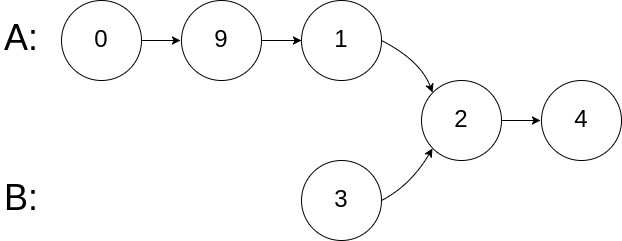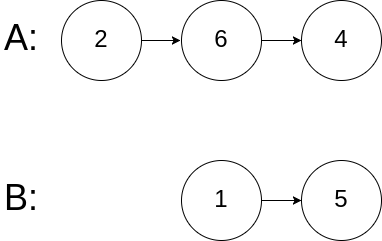Description
https://leetcode.com/problems/intersection-of-two-linked-lists/
Write a program to find the node at which the intersection of two singly linked lists begins.
For example, the following two linked lists:

begin to intersect at node c1.
Example 1:

Input: intersectVal = 8, listA = [4,1,8,4,5], listB = [5,0,1,8,4,5], skipA = 2, skipB = 3 Output: Reference of the node with value = 8 Input Explanation: The intersected node's value is 8 (note that this must not be 0 if the two lists intersect). From the head of A, it reads as [4,1,8,4,5]. From the head of B, it reads as [5,0,1,8,4,5]. There are 2 nodes before the intersected node in A; There are 3 nodes before the intersected node in B.
Example 2:

Input: intersectVal = 2, listA = [0,9,1,2,4], listB = [3,2,4], skipA = 3, skipB = 1 Output: Reference of the node with value = 2 Input Explanation: The intersected node's value is 2 (note that this must not be 0 if the two lists intersect). From the head of A, it reads as [0,9,1,2,4]. From the head of B, it reads as [3,2,4]. There are 3 nodes before the intersected node in A; There are 1 node before the intersected node in B.
Example 3:

Input: intersectVal = 0, listA = [2,6,4], listB = [1,5], skipA = 3, skipB = 2 Output: null Input Explanation: From the head of A, it reads as [2,6,4]. From the head of B, it reads as [1,5]. Since the two lists do not intersect, intersectVal must be 0, while skipA and skipB can be arbitrary values. Explanation: The two lists do not intersect, so return null.
Notes:
- If the two linked lists have no intersection at all, return
null. - The linked lists must retain their original structure after the function returns.
- You may assume there are no cycles anywhere in the entire linked structure.
- Your code should preferably run in O(n) time and use only O(1) memory.
Explanation
Find from the second list which node exists in the first list
Python Solution
# Definition for singly-linked list.
# class ListNode:
# def __init__(self, x):
# self.val = x
# self.next = None
class Solution:
def getIntersectionNode(self, headA: ListNode, headB: ListNode) -> ListNode:
visited = set()
while headA != None:
visited.add(headA)
headA = headA.next
while headB != None:
if headB in visited:
return headB
headB = headB.next
return None
- Time complexity: O(N).
- Space complexity: O(1).
I found that solution is very popular and helpful : https://www.youtube.com/watch?v=TxjA3ciq95I
/** Java solution ***
public ListNode getIntersectionNode(ListNode headA, ListNode headB) {
if (headA == null || headB == null) return null;
int lenA = getLength(headA), lenB = getLength(headB);
if (lenA > lenB) {
for (int i = 0; i < lenA – lenB; ++i) headA = headA.next;
} else {
for (int i = 0; i < lenB – lenA; ++i) headB = headB.next;
}
while (headA != null && headB != null && headA != headB) {
headA = headA.next;
headB = headB.next;
}
return (headA != null && headB != null) ? headA : null;
}
public int getLength(ListNode head) {
int cnt = 0;
while (head != null) {
++cnt;
head = head.next;
}
return cnt;
}